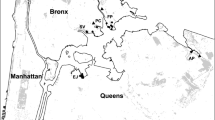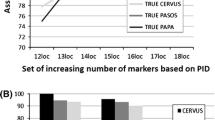Abstract
Elucidating the genetic relationships among members of a social group is indispensable in studying any social system of primates.Hylobates spp. are believed to be monogamous, although some long-term monitoring studies have provided conflicting evidence. We applied a parentage testing technique to a group ofHylobates muelleri in the wild. Forty-five microsatellite loci were screened in the 12 unrelated gibbons' DNA, and 16 of the 45 loci were found to be polymorphic. Hair and fecal samples from 15 gibbons in the field were collected non-invasively. In each sample, the 16 polymorphic loci were amplified by PCR using appropriate primer pairs and separated by electrophoresis. We estimated three pairs of parents-offspring, a pair each of both father-offspring, and mother-offspring genetic relationships. Further, in two of the five cases, we revealed the family a subadult lived with was not a natal one of the subadult. The non-invasive sampling methods and polymorphic primer pairs used in this study would greatly enhance the understanding of gibbon's society in the wild.
Similar content being viewed by others
References
Boom, R.;Sol, C. J. A.;Salimans, M. M. M.;Jansen, C. L.;Weltheim van Dillen, P. M. E.;van der Noordaa, J. 1990. Rapid and simple method for purification of nucleic acids.J. Clin. Microbiol., 28: 495–503.
Brockelman, W. Y.;Reichard, U.;Treesucon, U.;Raemaekers, J. J. 1998. Dispersal, pair formation and social structure in gibbons (Hylobates lar).Behav. Ecol. Sociobiol., 42: 329–339.
Brockelman, W. Y.;Srikosamatara, S. 1984. Maintenance and evolution of social structure in gibbons. In:The Lesser Apes: Evolutionary and Behavioural Biology,Preuschoft,H.;Chivers,D. J.;Brockelman,W. Y.;Creel,N. (eds.), Edinburgh Univ. Press, Edinburgh, pp. 298–323.
Carpenter, C. R. 1940. A field study in Siam of the behavior and social relations of the gibbonHylobates lar.Comp. Psychol. Monogr., 16: 1–212.
Constable, J. J.;Packer, C.;Collins, D. A.;Pusey, A. E. 1995. Nuclear DNA from primate dung.Nature, 373: 393.
Domingo-Roura, X.;López-Giráldez, T.;Shinohara, M.;Takenaka, O. 1997. Hypervariable microsatellite loci in the Japanese macaque (Macaca fuscata) conserved in related species.Amer. J. Primatol., 43: 357–360.
Hayakawa, S.;Takenaka, O. 1999. Urine as another potential source for template DNA in polymerase chain reaction (PCR).Amer. J. Primatol., 48: 299–304.
Inoue, M.;Takenaka, O. 1993. Japanese macaque microsatellite PCR primers for paternity testing.Primates, 34: 37–45.
Kreader, C. A. 1996. Relief of amplification inhibition in PCR with bovine serum albumin or T4 gene 32 protein.Appl. Environ. Microbiol., 62: 1102–1106.
Mullis, K. B.;Faloona, F. A. 1987. Specific synthesis of DNAin vitro via a polymerase-catalysed chain reaction. In:Methods in Enzymology, Vol. 155,Wu,R. (ed.), Academic Press, New York, pp. 335–350.
Nievergelt, C. M.;Mundy, N. I.;Woodruff, D. S. 1998. Microsatellite primers for genotyping common marmosets (Callithrix jacchus) and other callitrichids.Mol. Ecol., 7: 1341–1349.
Oka, T.;Iskandar, E.;Ghozali, D. I. 2000. Effects of forest fragmentation on the behavior of Bornean gibbons. In:Rainforest Ecosystems of East Kalimantan: El Niño, Drought, Fire and Human Impacts.Guhardja, E.;Fatawi, M.;Sutisna, M.;Mori, T.;Ohta, S. (eds.), Ecological Studies 140, Springer-Verlag, Tokyo, pp. 229–241.
Palombit, R. 1994. Dynamic pair bonds in Hylobatids: implications regarding monogamous social systems.Behaviour, 128: 65–101.
Reichard, U. 1995. Extra-pair copulations in a monogamous gibbon (Hylobates lar).Ethology, 100: 99–112.
Saiki, R. K.;Scharf, S.;Faloona, F.;Mullis, K. B.;Horn, G. T.;Erlich, H. A.;Arnheim, N. 1985. Enzymatic amplification of beta-globin genomic sequences and restriction site analysis for diagnosis of sickle cell anemia.Science, 230: 1350–1354.
Taberlet, P.;Waits, L. P. 1998. Non-invasive genetic sampling.Trends Ecol. Evol., 13: 26–27.
Takasaki, H.;Takenaka, O. 1991. Paternity testing in chimpanzees with DNA amplification from hairs and buccal cells in wadges: a preliminary note. In:Primatology Today,Ehara,A.;Kimura,T.;Takenaka,O.;Iwamoto,M. (eds.), Elsevier, Amsterdam, pp. 612–616.
Takenaka, O.;Takasaki, H.;Kawamoto, S.;Arakawa, M.;Takenaka, A. 1993. Polymorphic microsatellite DNA amplification customized for chimpanzee paternity testing.Primates, 34: 27–35.
Tegelström, H. 1986. Mitochondrial DNA in natural populations: an improved routine for the screening of genetic variation based on sensitive silver staining.Electrophoresis, 7: 226–229.
Tilson, R. I. 1981. Family formation strategies of Kloss's gibbons.Folia Primatol., 35: 259–281.
Woodruff, D. S. 1993. Non-invasive genotyping of primates.Primates, 34: 333–346.
Author information
Authors and Affiliations
About this article
Cite this article
Oka, T., Takenaka, O. Wild gibbons' parentage tested by non-invasive DNA sampling and PCR-amplified polymorphic microsatellites. Primates 42, 67–73 (2001). https://doi.org/10.1007/BF02640690
Received:
Accepted:
Issue Date:
DOI: https://doi.org/10.1007/BF02640690




